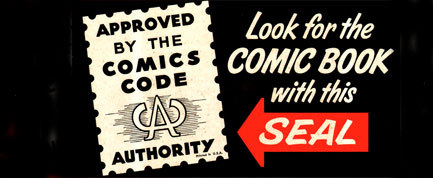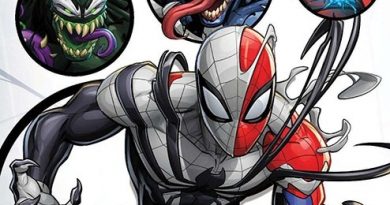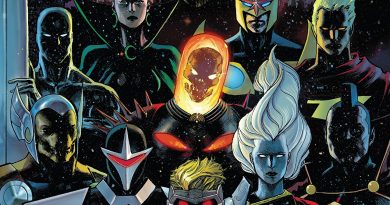Comics Cornerstone Special Edition: Making the Case for Comics as a Form of Literature
Hello again, fine readers! Today, I have something a little bit different for you. No comic or movie reviews or anything of the sort. Instead, I’d like to discuss an issue that I’ve seen become more and more relevant– especially in my personal life. The question is “Can comic books and related media be considered legitimate forms of storytelling?” I would argue yes. But just saying it is isn’t a compelling argument. So, to make my case, I’ll be providing an extended dissertation with several examples to help get my point across. Readers, I hope you are ready for a long ride! Let’s get started!
The dictionary defines literature as “writings in which expression and form, in connection with ideas of permanent and universal interest, are characteristic or essential features, as poetry, novels, history, biography, and essays.” Basically, anything that tells a narrative. So, why can’t that apply to comic books? The truth is, it can! Some will argue that comics don’t count because they have pictures in them. But, that argument doesn’t make any sense. Children’s books are filled with pictures and, usually, there is always a lesson to be taught in the end. Ergo, there must be a story for there to be a lesson. So, this backward mentality that art can’t be mixed with literature to tell a coherent story is illogical.
Let’s start looking at some examples. I think it’s best to start off with one of my favorite stories in “Amazing Spider-Man.” In 1973, the head honchos at Marvel decided that there needed to be a major shake-up for Spider-Man to boost sales of the book. At the time, Peter Parker was in a very serious relationship with his first real girlfriend, Gwen Stacy. In fact, there wasn’t much farther they could go without being married. “Who wants Spider-Man to be married?” That was the question floating around the Spider-Man office at Marvel and the very idea was ridiculous. So, in the now infamous story written by Gerry Conway, Spider-Man failed to save his love from falling off a bridge (specifically the George Washington bridge) at the hands of The Green Goblin. It’s a story that not only changed Spider-Man forever but also the very landscape of comics themselves and really ushered in what we now call “The Bronze Age.” Now, here’s my point: that kind of tragic storytelling isn’t just exclusive to romance novels or dramatic novels. Even in superhero stories, one can find a tale as sad as the hero losing the love of his life. That’s a very mature subject and Conway was brave enough to believe that the readers would understand the weight of what had just happened. Spider-Man would never be the same–and neither would comics–after “The Night Gwen Stacy Died.”
Comics would take another big leap forward in 1986 with the debut of Frank Millar’s “The Dark Knight Returns.” Set in an alternate universe, “The Dark Knight Returns” follows Bruce Wayne 10 years after retiring as Batman. However, with crime rates soaring to unforeseen levels and a new cult on the rise, a fifty-something Bruce Wayne must don the cape and cowl once more to prowl the streets of Gotham City. It’s a grittier take on the character that had never been seen before and, quite honestly, has rarely been seen since. But, that was exactly what Millar intended. After all, Batman is a tragic figure. Maybe even a bit insane. The brightly colored campiness of the Adam West TV show wasn’t realistic to who Bruce Wayne/Batman would be if he actually existed. There are more heavy concepts in this book than one can shake a stick at. Mental health being the most prominent.
“The Death of Superman” is yet another perfect example of what comics can truly be. As children, we see the adult figures in our lives as these invincible, inspiring people who can do no wrong and to whom nothing bad ever happens. It’s not until we get older that we realize how wrong we are. Except, Superman is meant to be that immortal figure to everybody. Everyone who read the comics and everyone who lived in the books thought he was unbreakable. One day, that all changed. “The Death of Superman”, in my opinion, showed us that no one, even our biggest heroes, is immortal. None of us are perfect. Death comes for everyone—even the strongest of us. We don’t know when and we don’t know how. But, eventually, our time will come.
“The Dark Knight” is maybe one of the best movies of the last 15 years. The 2008 Batman film directed by Christopher Nolan is really, at its core, about the duality of mankind and how there’s a dark side and light side in everyone. What matters is what side you choose to express. The main villain of the film, The Joker, (Heath Ledger) wants nothing more than to instigate chaos and anarchy. It’s not about the money for him. It’s about bringing out our chaotic side. That’s the one thing that Batman (Christian Bale) can’t understand. Why? Because as someone who inflicts vigilante justice and seeks to bring order, he’s always looking for the motivation behind the act. That’s also part of the detective nature in him. Except, The Joker has no motivation other than inciting anarchy. The Joker won’t be stopped until he’s dead or captured. Throughout the entire movie, no one can capture or kill him. The only one who can come close to doing either of those things is Batman. But, Batman doesn’t kill. And The Joker knows it. Therefore, Batman is always being challenged to break his one rule because it might be the only way to stop the madness. That’s the question being posed throughout the entire movie: how far should one go to bring order where there is chaos? Because chaos is all that some people want. “Some men just want to watch the world burn.”
In my opinion, one of the best cautionary tales about actions having consequences is “Avengers: Infinity War.” If you ask me, this movie makes us take a real good look at how our advancements in society are affecting the world around us. The villain, Thanos (Josh Brolin), says that he saw his homeworld becoming overpopulated. Overpopulation is a very real problem humanity currently faces. It can’t be something we continue to ignore because let’s be honest, Earth can’t support 8 billion more people with our current rates of resource consumption. “The universe is finite. It’s resources finite.” After being called a laughing stock by his government, the apocalypse Thanos predicted came to pass. As the last surviving Titan, he now sees it as his duty to prevent the rest of the universe from becoming overpopulated. How does he plan to accomplish his goals? By finding the six Infinity Stones and using them to wipe out half the universes’ population at random. Yes, he knows that’s genocide. However, his mentality is that the needs of the many outweigh the needs of the few. He doesn’t take pleasure in what he plans to do. But, as Thanos would say, “The hardest choices require the strongest wills.”
There’s a great new book that I just started reading called “Super Soldier” by Jason Inman. In the book, Inman relates his own experiences in Iraq to comic book characters who also served in the military. My favorite example is, of course, Captain America. Inman explains that Captain America is the perfect illustration of the American ideal. What does that mean, exactly? It means that he’ll always do what is right. That doesn’t necessarily mean following orders because sometimes to follow orders is to go against your own moral compass. Cap would never do that. He’ll always stand for what he believes is right for not only the country but the world as well. Sometimes doing what is right means going against what others tell you to do. Inman explains that this principle is also true in the military. If an order goes against what you believe or know to be right, then it’s your duty to disobey that order. That might seem hard to believe given our preconceived notions about the military. But, that fact is coming right from a veteran who had to disobey warriors once or twice.
Another one of the biggest things that comics have dealt with in the past 50 years is addiction. In 1971, Marvel was tasked with using their flagship book, “The Amazing Spider-Man”, to promote the fight against marijuana and other hard drugs. The three-part story went down in issues 96-98 and featured Peter Parker’s best friend, Harry Osborn, dealing with an addiction to heroin. The story received pushback from the Comics Code Authority but, in the end, the story was published and sent to stores without the CCA’s approval. It was a controversial move at the time. But, Stan Lee believed that the code was wrong if they couldn’t see that he was trying to better society through his story. “The Invincible Iron Man” went through a similar phase during the “Demon in a Bottle” storyline. The story dealt with Tony Stark diving deep into his alcoholism after a series of traumatic events. His addiction got so bad that his best friend, James Rhodes, took over the mantle of Iron Man for a string of issues until Tony could no longer ignore his destiny. Both tales were controversial when they were published. However, they helped bring attention to larger issues that are still relevant today and might have even set some people down a better path.
I could go on and on with more examples– “Spider-Man: Kraven’s Last Hunt”, “Batman: Knightfall”, “Daredevil: Guardian Devil”– these are all great comic books! Now, are some stories sillier than others? Yes. But, even the most ridiculous story has some semblance of an underlying message. And yes, there are comics made specifically for kids. But, they aren’t confined to being that and haven’t been for a long time. There’s a comic for all levels of maturity and intellect. The form a story takes is irrelevant compared to the content within. Comic books can tell a compelling story with a message that rings true. The idea that art and literature, two very adult things, combine to make something childish is simply backward thinking. That thought process simply doesn’t make sense—especially in this day and age where comic book movies have completely taken over the cultural zeitgeist. Compelling stories aren’t simply confined to a 200-page novel that you get off the shelf at the library. Those are great—but a good story doesn’t have to be void of superheroes or supernatural elements. Heck, the very antithesis for the X-Men is that they’re intended to be a very sci-fi bent allegory for racism and segregation. “Captain America: Civil War” is a political drama about what would happen if superheroes really existed. We need to move past this notion that comics and superpowers are something that comes from the imagination of a 10-year-old. An intriguing story can come from anywhere. It doesn’t matter what form it takes as long as it’s [1]“A good story, well told.”
For more examples, check out my bibliography below!
[1] George Lucas
Aaron, Jason, and Russell Dauterman. The Mighty Thor, Vol. 1: Thunder In Her Veins. 1st ed., vol. 1 5, Marvel Enterprises, 2016.
Arad, Avi, et al. Iron Man. Performance by Robert Downey Jr., Iron Man, Paramount Pictures, 2008.
Burton , Tim, director. Batman. Performance by Michael Keaton , Batman, Warner Bros., 1989.
“Civil War SPOILER REVIEW and More Marvel News! – Marvel Movie News Ep 82.” Performance by Coy Jandreau, YouTube, YouTube, 12 May 2016, www.youtube.com/watch?v=zpE6tBxWqq4&list=PLsubzWvFXmVTYUIkGqoG78Yj6vb2hAFmL&index=31&t=0s.
Claremont, Chris, and John Byrne. X-Men: The Dark Phoenix Saga. Vol. 1, Marvel, 2012.
Conway, Gerry. Amazing Spider-Man – the Night Gwen Stacy Died. Panini Publishing Ltd, 2009.
David, Peter. Spider Man Vault: a Museum-in-a-Book with Rare Collectibles Spun from Marvel’s Web. Running, 2011.
Feige, Kevin, et al. Captain America, the Winter Soldier. Performance by Chris Evans, et al., Captain America: The Winter Soldier, Walt Disney Studios Motion Pictures, 2014.
Ginocchio, Mark. 100 Things Spider-Man Fans Should Know & Do before They Die. Triumph Books, 2017.
Hodson, Christina. Bumblebee . Performance by Hailee Steinfeld, Bumblebee , Paramount , 2018.
Inman, Jason. Super Soldiers: a Salute to the Comic Book Heroes and Villains Who Fought for Their Country. Mango Media, 2019.
Jenkins , Patty, director. Wonder Woman. Performance by Gal Gadot, Wonder Woman , Warner Bros., 2017.
Jurgens, Dan, et al. Superman: the Death and Return of Superman Omnibus. New Edition ed., vol. 1, DC Comics, 2019.
Langley, Travis, et al. Captain America vs. Iron Man: Freedom, Security, Psychology. Sterling, 2016.
Lee, Stan, and Steve Ditko. The Amazing Spider-Man Omnibus Volume 1. Second ed., vol. 1, Marvel Enterprises, 2016.
Lee, Stan, et al. Amazing Fantastic Incredible: a Marvelous Memoir. Gallery 13, 2019.
Loeb, Jeph, and Tim Sale. Spider-Man Blue. Marvel, 2011.
Markus, Christopher, and Stephen Mcfeely. Avengers: Infinity War. Performance by Robert Downey Jr., et al., Avengers: Infinity War, Marvel Studios , 2018.
Markus, Christopher, and Stephen Mcfeely. Captain America : Civil War. Performance by Chris Evans, et al., Captain America: Civil War , Marvel Studios , 2016.
Michelinie, David, et al. The Invincible Iron Man: Demon In A Bottle. Panini, 2010.
Miller, Frank. Batman: The Dark Knight Returns ( -30th Anniversary). 30th Anniversary ed., vol. 1, DC Comics, 2016.
Moench, Doug, et al. Batman: Knightfall, Vol. 1. 1st ed., vol. 1 3, DC Comics, 2012.
Nolan, Christopher, director. The Dark Knight Trilogy. Performance by Christian Bale, and Heath Ledger, The Dark Knight, Warner Bros Pictures, 2012.
Rothman , Rodney, et al., directors. Spider-Man: Into The Spider-Verse. Performance by Shameik Moore , et al., Spider-Man: Into The Spider-Verse, Sony Animation , Dec. 2018.
“Spider-Man (Peter Parker) | Characters | Marvel.” Marvel Entertainment, Marvel.com, 2016, www.marvel.com/characters/spider-man-peter-parker.
Straczynski, J Michael. Amazing Spider-Man by J.Michael Straczynski Omnibus Volume 1. Vol. 1, MARVEL COMICS, 2019.
Tucker, Reed. Slugfest: inside the Epic, 50-Year Battle between Marvel and DC. Sphere, 2017.
Watts, Jon, director. Spider-Man: Homecoming. Performance by Tom Holland , Spider-Man: Homecoming , Sony Pictures Home Entertainment, 2017.
Wilson, G. Willow, and Adrian Alphona. Ms. Marvel Volume 1: No Normal . Vol. 1, Marvel Worldwide, Inc., a Subsidiary of Marvel Entertainment, LLC, 2014.






